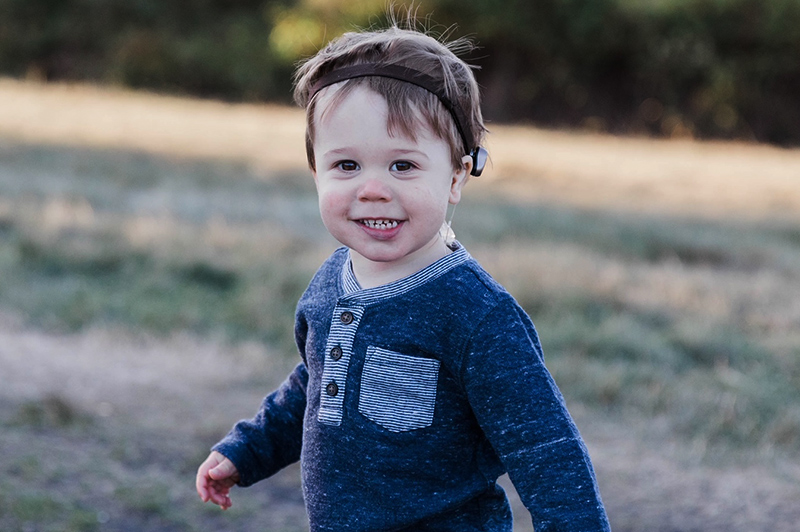Comprehensive care for children with outer- and middle-ear conditions
The Bone-Anchored Hearing System (BAHS) Program at Boston Children’s Hospital provides comprehensive, well rounded, amplification for pediatric, adolescent, and young adult patients with hearing loss for which a traditional hearing aid is ineffective.
Boston Children's BAHS Program is made up of a well-respected team of audiologists, speech pathologists, psychologists, and surgeons who work seamlessly with a multitude of specialties throughout the hospital. Having fit numerous ears with surgical BAHS implants and provided non-surgical options for many others, we are experts in the field of pediatric bone conduction amplification.
What is bone-anchored hearing and how does it work?
A bone-anchored hearing system is a type of hearing device. While a traditional hearing aid sits on the ear and sends amplified sound through the ear canal, a bone-anchored hearing device doesn’t need an external ear or ear canal to transmit sound to the brain. This makes it a great choice for individuals with microtia, atresia, stenotic ear canals, and other outer- and middle-ear conditions.
A bone-anchored hearing system works by sending sound directly to the inner ear (cochlea) through vibration. The device is placed on the head near the ear. It is held in place by either a softband, which looks similar to a headband, or a surgically placed implant. The device’s vibrations send sound directly to the inner-ear structures through the bone of the skull, bypassing the outer and middle ear.
Bone-anchored hearing technology is similar to bone conduction headphones that allow you to listen to music without putting the headphones in your ears.
Care for specialty populations
Bone-anchored hearing devices are highly specialized for the patients we work with. Our interdisciplinary team works with you to ensure a bone-anchored hearing device is the right choice for you and your family.
Some examples of conditions for which bone-anchored hearing devices may be appropriate include:
- chronic ear disease (infections, cholesteatoma, middle ear fluid) for which other medical interventions are not possible
- ear canal stenosis (narrowing)
- aural (external auditory canal) atresia and/or microtia
- congenital syndromes such as Treacher Collins syndrome, Nager syndrome, and hemifacial microsomia
- ossicular (hearing bones) disease
- traumatic injury to middle-ear structures
- conductive or mixed hearing loss
- unilateral profound sensorineural hearing loss (single sided deafness), either present at birth or acquired by sudden loss, tumor, or other hearing nerve injury
We provide top quality, easily accessible care at Boston Children’s locations in Boston, Waltham, Lexington, Peabody, Weymouth, and North Dartmouth.

Owen's bone-anchored hearing story
With the help of his bone-anchored hearing system, Owen is fluent in both spoken English and American Sign Language.
Services for children with hearing loss
Our team provides:
- comprehensive evaluation by an audiologist, speech and language pathologist, psychologist, and otolaryngologist (ear, nose, and throat doctor)
- assessment of your child’s language skills and potential to benefit from a bone-anchored hearing system
- comprehensive information about available educational and communication options
- BAHS candidacy evaluation and surgery
- BAHS programming services, ongoing care, professional support, and education to families
Industry expertise
Our team has expertise in dispensing and programming devices from the following manufacturers:
- Oticon Medical: Ponto (surgical and softband) devices
- Cochlear Americas: BAHA (surgical, softband, and sound arc) and Osia devices
- MedEl: AdHear and BoneBridge devices
Why choose the BAHS Program at Boston Children’s?
Our bone-anchored hearing audiologists have extensive experience treating patients from infancy to adulthood. As hearing technology continues to change, we ensure each of our patient’s devices grow as they do. Whether your child has temporary hearing loss due to recurrent ear infections, or permanent hearing loss due to microtia, atresia, or another craniofacial anomaly, we are here to support your family throughout your entire journey.
Because no two children are exactly the same, we provide personalized care for each patient. Whether you are considering bone-anchored hearing for the first time or have extensive experience with this type of device, we will discuss the benefits and challenges of each type of device with you and, if needed, offer in-office demonstrations and short-term loaner options.
As any parent knows, a child’s need to hear goes beyond the clinic and the home. That’s why we work closely with our patients’ schools to recommend and facilitate products that will provide the best possible auditory access in the classroom.

